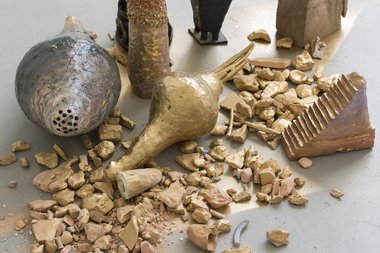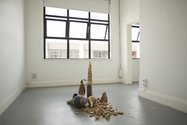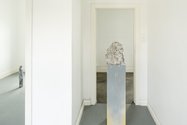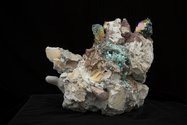John Hurrell – 24 February, 2014
Her main preoccupations seem to be textural and surface qualities presented within the format of developing chaos. The work is extremely compact, restless in its constant exploration of new surface qualities, elongated forms and chromatic nuances. What is alluring is the intricate fine detail blended with the strangeness of her use of ‘clean' dirt - quite different from the more stable and less messy, ‘ungranular' projects found with many other artists.
The second show by Suji Park at Ivan Anthony, All there is is related to her Elam presentation last November at George Fraser, but as an installation not so sprawling or floor-based. Here we see, like last time, her discrete ceramic ‘sculptures’ (portable pieces of purchasable 3D art) but now merged - via spray paint, scattered crumbs and shards of baked clay and rubble - into the plinth or floor. Her work - with her choice of materials - has obvious connections with Francis Upritchard, Kate Newby and Karl Fritsch, yet an anarchistic (apparently) impromptu sensibility gives her voice added individuality.
In the four rooms - the section of Ivan Anthony to the left of the stairs - are nine separate works. The list of substances used within these ceramics is extraordinarily long: copper, wood, concrete, fired and unfired clay, plaster, acrylic, tempera, gesso, nail glue, pearls, glass beads, stone pigment, bismuth, Swarovski crystals, quartz, garnet, mica, silver and gold leaf, foam, epoxy, and rope. Sometimes compacted like exposed strata, other times spread out, dry and disintegrating; sometimes hanging, other times stacked up; occasionally on a shelf on a wall, also in a glass cabinet - Park likes to keep her audience guessing.
Her main preoccupations seem to be textural and surface qualities presented within the format of developing chaos. The work is extremely compact, restless in its constant exploration of new surface qualities, elongated forms and chromatic nuances. What is alluring is the intricate fine detail blended with the strangeness of her use of ‘clean’ dirt - quite different from the more stable and less messy, ‘ungranular’ projects found with the other artists mentioned above.
Park has an interest in spilling off and scattering around her objects, but without the interest in theory of artists like Smithson, or writers like Krauss. Her works contain gorgeously soft colour mixed with the powdery, splintery and shiny to make forms that very vaguely suggest vertical human figures, whilst also being ruined portions of a smashed up building or street. They allude to civic tragedy while also hinting at a community resurrection, a resurgence of the human spirit.
Her forms are also deliberately suggestive and vague. They could be anthills, fungal growths or fortresses, as well as humans. In a sense the morphological aspects are irrelevant because oddly the embedded ingredients and surface elements often dominant your interest so much you forget about the sculptural mass. You are hooked on the minutiae of detail, discovered on a ‘painting’ you keep walking around. Then you snap out of it, stand back and consider the totality, the heavy three-dimensional archaeological forms under your nose.
John Hurrell













 Two Rooms presents a program of residencies and projects
Two Rooms presents a program of residencies and projects Advertising in this column
Advertising in this column



This Discussion has 0 comments.
Comment
Participate
Register to Participate.
Sign in
Sign in to an existing account.